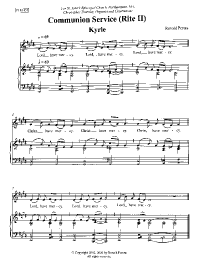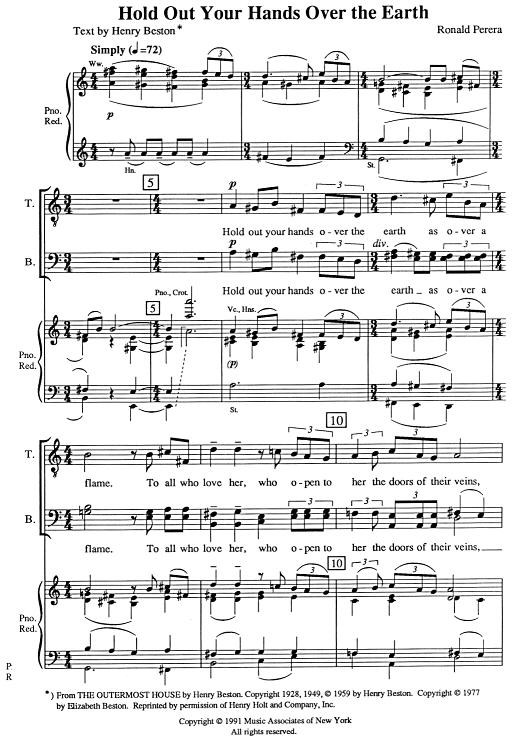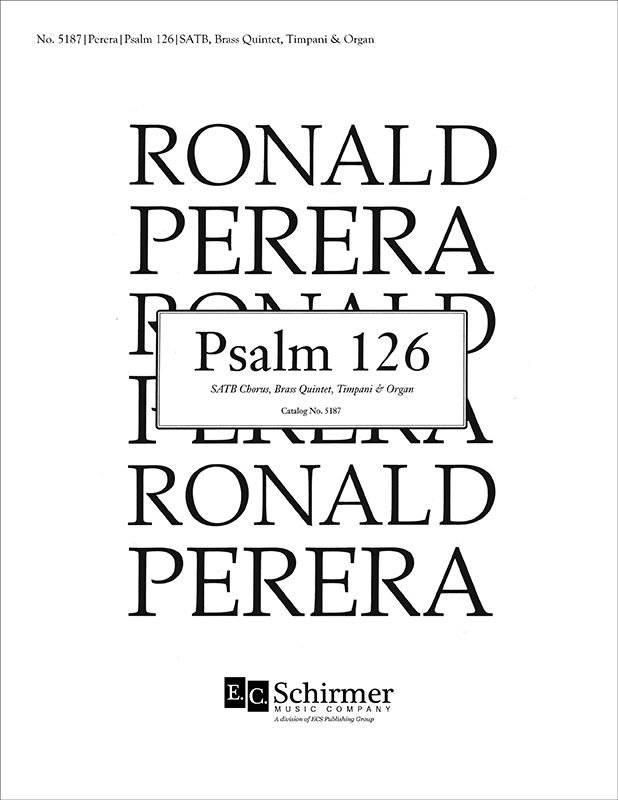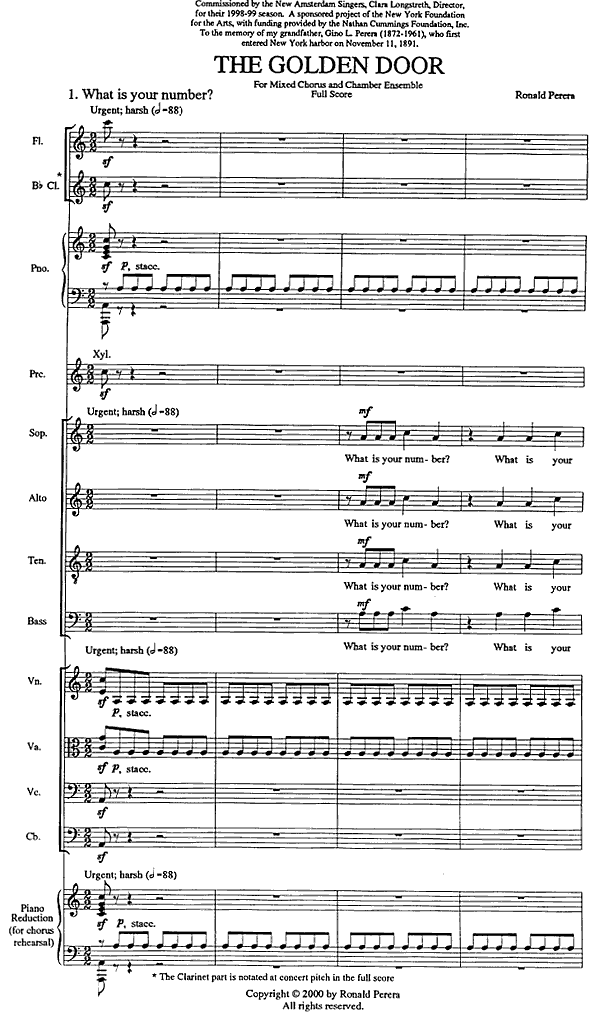Composition
Soprano, Horn, and Piano
Written for soprano Gretchen d’Armand. Text by Robert Louis Stevenson.
Movements:
- The Sun’s Travels
- Rain
- The Swing
- At the Sea-Side
- Auntie’s Skirts
- Happy Thought
- Summer Sun
| Composed: | 1978 |
| Duration: | 15:00 |
| Publisher: | E. C. Schirmer Music Company |
| Catalog Number(s): | 0167 |
Reviews:
Children of the Sun is a cycle of seven songs set to poetry by Robert Louis Stevenson. The pieces are light-hearted and fun, imaginatively set in atonal musical language. Each piece depicts a tiny scene or mood, with titles like Rain, At the Sea Side, and Summer Sun. For example, in The Swing, Perera employs Sprechstimme to express the excitement of a child going up and down on a swing. Tremolos and sweeping glissandos depict the swing’s movements. One particularly playful piece is Auntie’s Skirts, written in a comic blues style.
Music Library Association, NOTES 3/84
Here are seven poems from that favorite collection for children, A Child’s Garden of Verse by Robert Louis Stevenson. Included are The Sun’s Travels, Rain, The Swing, At the Sea Side, Auntie’s Skirts, Happy Thought, and Summer Sun. The words create a world of serenity and happiness. The music reflects this: some of the words suggesting the mood at the beginning of each song are “exuberantly,” “vividly,” “impetuously,” “very marked,” “with serenity.” The music is very dissonant, with little sense of tonality, but the melody line carries the text expressively, and all the parts dance along most attractively. The horn some times reinforces the voice or piano, but more often adds a new melody. This is delightful music, about sixteen minutes in length, with a pitch range for the soprano C4 – A5.
NATS Bulletin 3/14/87

Score Sample:
Audio Excerpt:
Gretchen d’Armand, soprano and Kenneth Fearn, piano
Movement 1:
Baritone and Piano or Orchestra [Flute (doubling piccolo), oboe, 2 clarinets (2nd doubling bass clarinet), bassoon, contrabassoon, horn, trumpet, trombone, harp, piano (doubling celesta), percussion (two players), strings]
The White Whale is a musical projection of Ahab’s madness as revealed in fragments of soliloquy and dialogue from nine different chapters of Herman Melville’s Moby Dick. The four movements do not attempt to mirror Melville’s continuous narrative. Instead, they reflect some of the novel’s greatest discontinuities by juxtaposing paradoxical aspects of Ahab’s character—aspects which are revealed one by one in non-successive chapters strung out like beads on a chain throughout the book—in a radically compressed time frame. The compression heightens awareness of the depth and complexity of Ahab’s personality and of his relationship to the whale while creating a particular dramatic tension of its own. The text of this work was adapted by the composer from Herman Melville’s Moby Dick.
Movements:
- The Prisoner
- In Nomine Diaboli
- The Symphony
- A Hump Like a Snow-Hill
| Composed: | 1981 |
| Duration: | 30:00 |
| Publisher: | E. C. Schirmer Music Company |
| Catalog Number(s): | Piano/Vocal Score, 4098 Full score and parts available for rental. |

Score Samples:
Audio Excerpts:
Sanford Sylvan, Baritone; Joel Rosenberg, Conductor; Orchestra of Five College Musicians
Movement 1:
Tenor, flute (doubling alto flute), clarinet (doubling bass clarinet), percussion (one player), violin, viola, cello, piano
Commissioned by Boston Musica Viva. Text by Ruth Whitman, Lawrence Ferlinghetti, Hart Crane, William Carlos Williams, and James Dickey.
 | Crossing the Meridian is the title work on the CD Crossing the Meridian, which offers a collection of Ronald Perera’s works for chamber music with voice. It includes Crossing the Meridian, Three Poems of Günter Grass, Visions and Alternate Routes. Performed by the Boston Musica Viva. Soloists include Elsa Charlston, John Aler, Jane Bryden, and Karen Smith Emerson. On CRI.Available on: Amazon iTunes |
Movements:
- I. July 18, 1846, Crossing the Great Divide
- II. That Sensual Phosphorescence
- III. Meticulous, Past Midnight
- IV. Danse Russe
- V. Math
| Composed: | 1982 |
| Duration: | 20:00 |
| Publisher: | E. C. Schirmer Music Company |
| Catalog Number(s): | Piano/Vocal Score, 4097 Full score and parts available for rental. |
Reviews:
Perera’s texts come from Ruth Whitman, Hart Crane, Lawrence Ferlinghetti, William Carlos Williams and James Dickey. They differ widely in tone and in method, but all concern themselves with in-between moments in which time is momentarily suspended, and the self is alone. The music, as the composer said in some prefatory remarks, is tonal, triadic, and transparent; like the poems, it concerns itself with limits, and transcending them. There is something cold about it, in an attractive sense — there is no self-indulgent swooning here.
Boston Globe
The first of a sequence of four concerts in St. John’s Smith Square contained no less than three British premieres, of which the most striking was Ronald Perera’s song-cycle Crossing the Meridian. Its debt to Britten is clear enough, but Perera’s music is sensitive to atmosphere and technically most expert and economical.
The Sunday Telegraph (London) 11/9/86
Two Sopranos, Flute, oboe, clarinet, bassoon, horn, 2 violins, viola, cello, contrabass, piano
Written in memory of Phillips Perera, the composer’s brother, a talented amateur painter. The work celebrates the creative artist in painting, poetry, and sculpture. Texts are by Susan Snively, Richard Wilbur, and Carol Edelstein.
   | Crossing the Meridian is the title work on the CD Crossing the Meridian, which offers a collection of Ronald Perera’s works for chamber music with voice. It includes Crossing the Meridian, Three Poems of Günter Grass, Visions and Alternate Routes. Performed by the Boston Musica Viva. Soloists include Elsa Charlston, John Aler, Jane Bryden, and Karen Smith Emerson. On CRI.Available on: Amazon iTunes |
Movements:
- Sky Above Clouds
- The Writer
- After Brancusi
| Composed: | 1993 |
| Duration: | 14:00 |
| Publisher: | Pear Tree Press Music Publishers distributed by Subito Music Corp. |
| Catalog Number(s): | Full Score, PTM 501 |
Reviews:
Visions, . . . scored for soprano duet and large chamber ensemble, shows the lyrical tendencies in the first song of Crossing the Meridian fully in flower. Perera’s idiom by 1992 had blossomed fully into tonality, and the music fairly glows with warmth. The three songs all deal with artistic creation, normally a big yawn as a subject for artistic exploration so far as I am concerned, in interestingly oblique ways. The first and last songs, dealing with painting and sculpture respectively, have the voices more or less moving in parallel textures. The second song, The Writer, concerns the poet and her daughter, who is writing her first story. The mother is portrayed by the singers alternating lines, the daughter by the voices together. Interestingly enough, although neither singer has the vocal endowments of Elsa Charlston, the effect when they sing together is to cancel out the flaws in each voice to utterly ravishing effect.
John Story, Fanfare Magazine, January/February 1999
SATB Chorus with Piano Accompaniment
Commissioned by the Da Camera Singers of Amherst, MA for their 2011 season. A setting of five early poems by Robert Frost.
Contents:
- To the Thawing Wind
- Stars
- Revelation
- Fire and Ice
- Going for Water
| Composed: | 2010 |
| Text: | Robert Frost |
| Duration: | 12:00 |
| Publisher: | Pear Tree Press Music Publishers distributed by Subito Music |
| Catalog Number(s): | PTM 4001 |
Reviews:
“Ronald Perera set “North Country,” five poems by Robert Frost. Their theme was self-concealment and, in the central poem, revelation. The music was perfectly fitted to the poetry, occasionally dissonant and more often delicate and clear, in keeping with the beautiful conclusion of “Going for Water” (the last poem), “We heard, we knew we heard the brook.” The chorus was the Northfield Mount Hermon Singers, whose young voices and disciplined performance were the musical and emotional highlight of the concert.”
Daily Hampshire Gazette 1/23/2014
Score Sample:
Audio Excerpts:
Performed by the Da Camera Singers; Sheila L. Heffernon, conductor; Craig Sanford, piano
5. Going for Water
Available for SSA or SATB choir with Organ Accompaniment
Composed for the 2009 Christmas Vespers concert at Smith College, which featured new music commissioned for the occasion based on chants composed by the 12th-century composer, artist and mystic Hildegard von Bingen. This Magnificat setting is inspired by Hildegard’s Marian antiphon Quia ergo femina. The original SSA version is dedicated to the Smith College Glee Club, Jonathan Hirsh, director.
| Composed: | 2009 |
| Text inspired by: | Hildegard von Bingen’s Marian antiphon Quia ergo femina |
| Duration: | 4:30 |
| Publisher: | E. C. Schirmer Music Company |
| Catalog Number(s): | SSA Version, 7624 SATB Version, 7625 |
Reviews:
“The Hildegard Magnificat takes its name from the source of the main musical motif, namely an antiphon by Hildegard von Bingen. This work is probably more at home in a concert setting than at an Evensong, and while it uses the Rite I text, it does not include a Gloria Patri. The Smith College Glee Club commissioned the work, thus the treble version is the original. The mixed choir arrangement simply redistributes the parts without changing a note of the organ. Perera approaches the text atmospherically, creating a sense of exalted mystery. The closing moments resolve the loose E minor tonality with a surprise Picardy third and minor seventh, and this nebulous harmony typifies the evocative effect of the entire setting. The treble version relies on part divisions to fill our harmonies, requiring an ensemble large enough to cover six parts. The mixed choir voicing would be accessible to most volunteer groups.”
The Journal of the Association of Anglican Musicians November, 2013
Score Samples:
SSA Audio Excerpt:
Audio excerpt performed by the Smith College Glee Club, Jonathan Hirsh, director, Grant Moss, organ.
SATB Chorus.
A cappella settings of three Emily Dickinson poems including the well known “Wild Nights.” Dedicated to Harold Rosenbaum and the New York Virtuoso Singers.
Movements:
- Ample Make This Bed
- Wild Nights
- Bring Me the Sunset In a Cup
| Composed: | 2009 |
| Text by: | Emily Dickinson |
| Duration: | 5:45 |
| Publisher: | Pear Tree Press Music Publishers distributed by Subito Music |
| Catalog Number(s): | 80500491 |
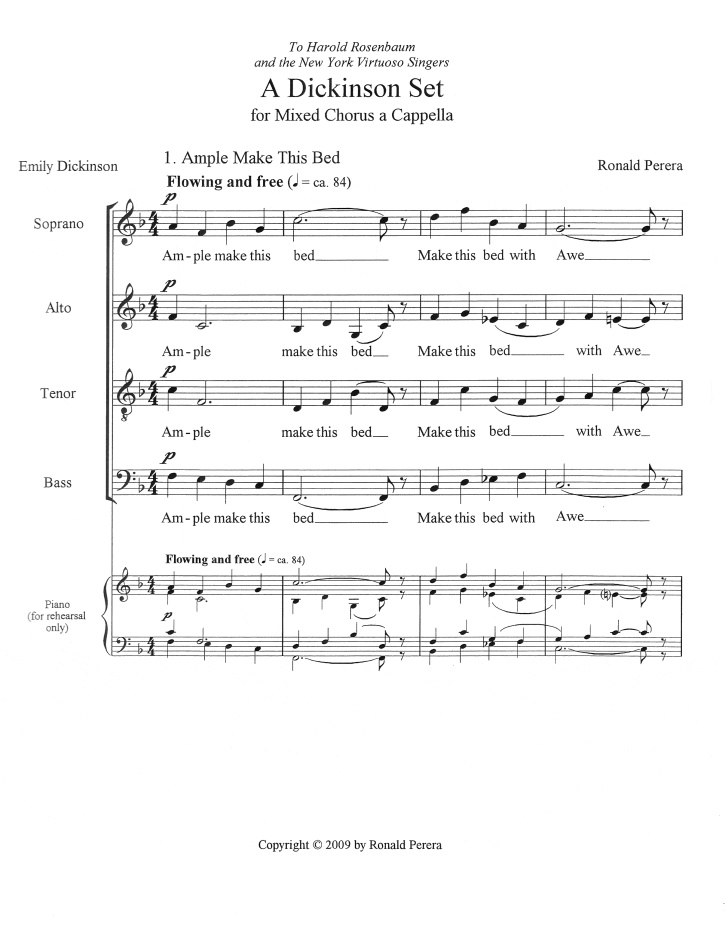

Audio Excerpt:
“Bring me the Sunset in a Cup” performed by the New Amsterdam Singers; Clara Longstreth, music director
SATB Chorus with String Quartet & Piano Accompaniment
Settings of eight Poems of Mary Oliver that are highly contrasting in texture and mood, trace a cycle in the natural world from dawn of one day to dawn of the next. This piece was co-commissioned by the Chatham Chorale and the New Amsterdam Singers.
| Composed: | 2006 |
| Text by: | Mary Oliver |
| Duration: | 23:005 |
| Publisher: | Pear Tree Press Music Publishing distributed by Subito Music |
| Catalog Number(s): | Piano/Vocal Score, 80500482 Full Score, 80500481 |
Reviews:
Poems by Mary Oliver are the basis of Ronald Perera’s colourful and poignant Why I Wake Early, named for the last of eight sections that move from one morning to the next. Both composers season their essentially tonal language with harmonic spices but what stands out in each score is expressive vocal and instrumental writing that flows from the texts with idiomatic grace and intensity. These are deeply affecting pieces and meaningful additions to the choral repertoire…. In his settings of the Oliver poems, Perera places the chorus in a series of glistening soundscapes in collaboration with string quartet and piano. The final titular poem basks in reflective beauty before taking euphoric wing on the words “I start the day in happiness, in kindness.”
Gramaphone (UK) December 2012
Nature demanded its due on Sunday afternoon, as clocks pushed forward for daylight savings time provided an extra hour of sunlight to observe debris strew by the ferocious windstorm on Saturday night. The New Amsterdam Singers seemed to have planned in advance with “As Nature Wakes,” an enjoyable mix of American and Czech works featuring nature as subject or metaphor, presented that afternoon at the Church of the Holy Trinity.
This adventurous amateur chorus, founded by the conductor, Clara Longstreth in 1968, celebrated its 40th anniversary with the New York premiere of Ronald Perera’s “Why I Wake Early,” jointly commissioned by it and the Chatham Chorale of Cape Cod, Mass. Mr. Perera set eight poems by Mary Oliver, a Cape Cod poet, for mixed chorus, string quartet, and piano.
Ms. Oliver’s poetry, which has drawn comparisons to the work of Emerson and Thoreau, reveals an awestruck regard of nature that verges on the religious: “What wretchedness, to believe only in what can be proven,” she writes in “I Looked Up,” the fifth poem in Mr. Perera’s cycle. Her work also demonstrates a discerning eye and an ability to render vivid images with a few deft strokes.
Mr. Perera sensitively underscores both attributes in a cycle spanning a day from one dawn to the next, linked by a subtle, recurring four-note motif. His music neatly conjures Ms. Oliver’s rippling pond, wary crows, flitting bats and lazily unspooling snake. At the same time, the work’s dramatic progression, from the shivering anticipation of “Morning at Great Pond” to the radiant affirmation of the concluding title poem, “Why I Wake Early,” does justice to the poet’s more transcendental intents. Enhanced by Mr. Perera’s estimable knack for setting English, this is a substantial addition to the choral canon.
The New York Times, 3/11/2008
Saturday’s Chatham Chorale concert at the Yarmouth Congregational Church gave listeners much to celebrate.
It marked the 20th year of Margaret Bossi’s tenure as director, and the concert became a special evening of Americana through works by composers with Massachusetts origins or connections — Leonard Bernstein, Irving Fine, Aaron Copland and the composer Ronald Perera. Perera’s composition Why I Wake Early, based on eight poems by Cape poet Mary Oliver, was given its world premiere and formed the centerpiece of the program.
In the tradition of the New England Transcendentalists like Emerson and Thoreau, Oliver’s poems are inspired by nature and our relationship to it. Her vision is essentially upbeat without denying the harsh realities of the natural world. She has written: “Every poem is music — a determined, persuasive, reliable, enthusiastic and crafted music.”
Perera, a Northampton resident who taught at Smith College for 30 years, has remarkably and faithfully caught and enunciated the spirit of that statement.
His music is eminently approachable (no hard lessons here in “self-improvement”) and wraps around the music of the poems comfortably and with telling effect.
In “Entering the Kingdom,” a piece about the poet tentatively entering the alien realm inhabited by crows, the composer used the time-tested techniques of a repeated passage in the bass, extended chords and skipping upward scales aided by dialogue from a skilled string quartet. In “Bats,” with its swooping choral and instrumental word painting and string and piano tremolos, the chorale sang well within itself presenting some of the best ensemble work of the evening.
The eighth and final setting of the work Why I Wake Early concludes the work on an unapologetically optimistic note. This is Perera’s second commission for the chorale, having written in 1991, The Outermost House, based on Henry Beston’s book about his solitary winter on the Cape in the mid-1920s.
Perera writes exceedingly well for the chorale and this work should find a permanent place in the American choral canon.
Cape Cod Times, 11/12/2007
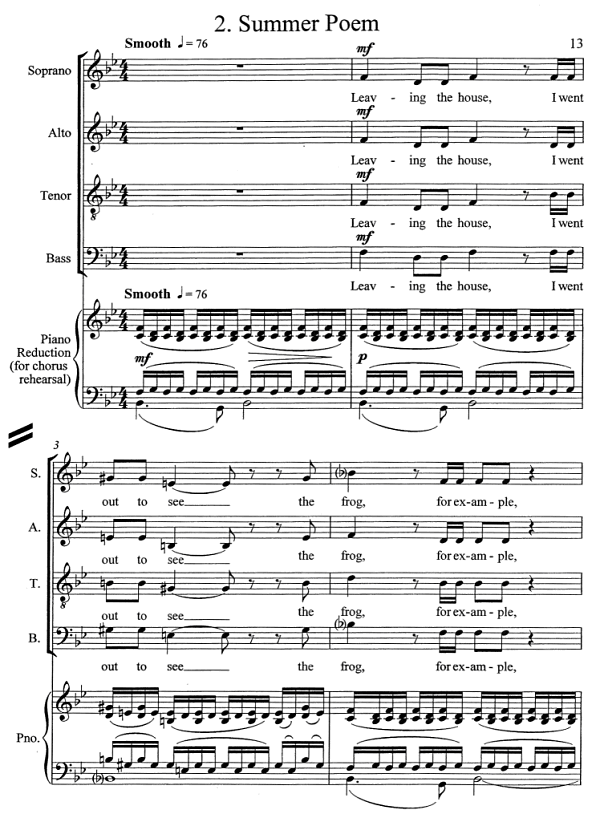

Audio Excerpt:
Audio excerpt is movement eight of Why I Wake Early. Performed by Coro Allegro, David Hodgkins, conductor, from the album Awakenings by Navona Records NV5878.
12. Why I Wake Early
Unison with Organ Accompaniment
A setting of the Kyrie, Gloria, Sanctus, Fraction Anthem and Agnus Dei intended for unison singing by choir and congregation. Composed for St. John’s Episcopal Church, Northampton, MA.
| Composed: | 2020 |
| Duration: | 6 min. |
| Publisher: | Pear Tree Press Music Publishers distributed by Subito Music |
| Catalog Numbers: | PTM 451 (full score) and PTM 452 (congregation part) |
| Voicing: | Unison |
| Accompaniment: | Organ |
SATB or TTB A Cappella
A Southern Folk-Hymn. Commissioned by the Harvard University Choir.
| Composed: | 1961 |
| Text by: | Anonymous |
| Duration: | 3:00 |
| Publisher: | E. C. Schirmer Music Company |
| Catalog Number(s): | SATB Version, 2715 TBB Version, 6217 |
Score Samples:
SATB Audio Excerpt: Harvard University Choir, John Ferris, conductor
SATB A Cappella
| Composed: | 1967 |
| Duration: | 2:00 |
| Publisher: | E. C. Schirmer Music Company |
| Catalog Number(s): | 2716 |
Solo Soprano, Tenor and Bass, SATB chorus and Flute (doubling piccolo), oboe, clarinet, bassoon, horn, trumpet, tenor trombone, bass trombone, percussion (2 players), harp, strings
A setting of the complete five-part Latin Mass. First performed in Washington National Cathedral in 1973 in memory of ZeBarney Thorne Phillips, former Dean of the Cathedral. NOTE: Can be ordered with a piano-vocal score, with a full orchestral score, with orchestral parts only, or with a two-piano accompaniment.
| Composed: | 1967 |
| Text by: | Latin Mass |
| Duration: | 25:00 |
| Publisher: | Pear Tree Press Music Publishing distributed by Subito Music |
| Catalog Number(s): | Study Score, PTM 401 Two Piano Vocal Score, PTM 401a Vocal Score with Piano Reduction, PTM401b Full score and parts are available for rental. |
Reviews:
Perera’s score is that incredible combination of lush orchestration and solemn choral passages which go straight to the heart.
Washington Star-News 5/10/73
The score is very attractive, with its articulate command of intriguingly sophisticated yet simple and fresh harmonic movement, nice melodic lines and well handled contrapuntal textures.
The Washington Post 5/10/73
Audio Excerpt:
New York Virtuoso Singers, Harold Rosenbaum, Conductor.
Soprano solo, SATB chorus, and Organ
Commissioned in memory of Samuel H. Miller by the Harvard University Choir for its annual carol service. The text is Christmas Carol by Samuel H. Miller.
| Composed: | 1968 |
| Text by: | Samuel H. Miller |
| Duration: | 6:00 |
| Publisher: | E. C. Schirmer Music Company |
| Catalog Number(s): | 2914 |
Reviews:
Samuel H. Miller’s poem is dramatically stated by Perera within contemporary sonorities. An independent organ part elevates itself as an equal to the more chordal lines. Organist as well as singers should be experienced in this Christmas work. Recommended for the better adult church choirs.
The Choral Journal 3/75
Soprano and Alto solo, SSAA chorus, Solo cello, percussion and piano
A work for the more advanced college- or university-level chorus. The texts are drawn from three woman poets of vastly different times and cultures, the Greek poet Sappho, the American imagist poet Adelaid Crapsey, and the Chinese poet Tzu Yeh. The second piece is a cappella.
Movements:
- Alone
- Triad
- I Am the North Pole
| Composed: | 1974 |
| Text attributed to: | Sappho, Crapsey, Yzu Weh |
| Duration: | 12:00 |
| Publisher: | E. C. Schirmer Music Company |
| Catalog Number(s): | Choral Score, 2834 |
Reviews:
Composed in 1974, the “Three Night Pieces” are settings of poems by Sappho (“Alone”), Adelaid Crapsey (“Triad”), and Tzu Yeh (“I am the North Pole”). Together their total duration is about twelve minutes. Though difficult and highly dissonant, the choral parts are not be yond the capacity of a well trained college ensemble; indeed the work is a worthy addition to the twentieth-century repertoire for women’s voices…. College-age singers can and probably should strengthen their musicianship on contemporary compositions such as this.
Music Library Association, NOTES 3/80
Two-part chorus (men’s, women’s or mixed) and Tape
The text is drawn from Psalms 148 and 150.
| Composed: | 1976 |
| Duration: | 6:00 |
| Publisher: | E. C. Schirmer Music Company |
| Catalog Number(s): | 3048 |
Soli and SSA/SSAA or SATB chorus with
2 flutes (2nd doubling piccolo), 2 oboes, 2 clarinets, 2 bassoons, 2 horns, 2 trumpets, percussion (one player), harp, strings or piano
A celebration of some of E. E. Cummings’ most vivid nature poetry. Commissioned by the Smith College Glee Club, Theodore Morrison, director.
  | Earthsongs is available on American Journey, a CD collection of unusual choral works in exciting performances. Performed by New Amsterdam Singers, Elizabeth Rodgers, piano, Clara Longstreth, conductor. On Albany Records, Troy108.Available from Albany RecordsAvailable on iTunes |
Movements:
- O sweet spontaneous earth
- in Just-spring
- as is the sea marvelous
- All in green went my love riding
- when god lets my body be
- i thank You God
| Composed: | 1983 |
| Text by: | E. E. Cummings |
| Duration: | 16:00 |
| Publisher: | E. C. Schirmer Music Company |
| Catalog Number(s): | Click here to purchase:SSA/SSAA Version 1. O sweet spontaneous earth, 5701 2. In Just-spring, 5702 3. As is the sea marvelous, 5703 4. All in green went my love riding, 5704 5. When God lets my body be, 5705 6. I thank You God, 5706 Additional Full Score, 4095 Full Score and parts available for rental. SATB Version 1. O sweet spontaneous earth, 7287 2. In Just-spring, 7288 3. As is the sea marvelous, 7289 4. All in green went my love riding, 7290 5. When God lets my body be, 7291 6. I thank You God, 7292 Additional Full Score, 4095 Full Score and parts available for rental. |
VIDEO: earthsongs mvt 3: “as is the sea marvellous”
Performed by the Wellesley College Women’s Choir at their Fall 2010 Concert
VIDEO: earthsongs mvt 6: “I thank you God”
Performed by the Chatham University Women’s Choir and the Chamber Orchestra of Pittsburgh
Reviews:
Ronald Perera, born in 1941, excels in choral music, and Clara Longstreth is doing a great service in bringing his work to the public. On the present disc we hear his Earthsongs (1983) on texts by e.e. cummings. These are sublime pieces, and immediately advance to the front rank of cummings’settings. “In Just-spring” and “as is the sea marvelous” are particularly fine, but in fact I like all six pieces.
Fanfare Magazine, Winter 1994 (review of Albany CD, Troy 108)
Score Sample:
SSA/SSAA Version Audio Excerpts:
New Amsterdam Singers, Clara Longstreth, conductor
1. O sweet spontaneous earth
2. In Just-spring
3. As is the sea marvelous
4. All in green went my love riding
5. When God lets my body be
6. I thank You God
SATB Version Audio Excerpts:
New Amsterdam Singers, Clara Longstreth, conductor
1. O sweet spontaneous earth
2. In Just-spring
3. As is the sea marvelous
4. All in green went my love riding
5. When God lets my body be
6. I thank You God
SSA and Piano
| Composed: | 1984 |
| Text by: | E. E. Cummings |
| Duration: | 5:00 |
| Publisher: | E. C. Schirmer Music Company |
| Catalog Number(s): | 4094 |


Score Sample:
Audio Excerpt:
Smith College Chamber Singers, Theodore Morrison, conductor
Narrator, SATB chorus, Synthesized accompaniment (CD) or Keyboard
A dramatic cantata in which the narrator sets forth, in English, events from the life of St. Francis, and the chorus sings, in Italian, the sections of his famous poem. Commissioned for the 100th anniversary of Groton School. St. Francis of Assisi’s poetry praises the creation of the sun, moon, earth, wind, water, fire. Very appealing synthesized accompaniment, excellent historical/performance notes. (Italian text in Umbrian dialect.)
   | The Outermost House: The late Robert Lurtsema narrates these colorful, melodic works. Includes Robert Perera’s The Outermost House performed by Chatham Chorale, Margaret Bossi, conductor, Nancy Armstrong, soprano, Robert J. Lurtsema, narrator and The Canticle of the Sun performed by Chatham Chorale, Margaret Bossi, conductor, Robert J. Lurtsema, narratorand .Available on: Albany Records iTunes |
Movements:
- Processional
- Reading No. 1
- Chorus, “Altissimu omnipotente bon signore”
- Reading No. 2
- Chorus, “Laudatu sie, mi signore”
- Reading No. 3
- Chorus, “Laudato si’, mi signore, per quelli che perdonano”
- Reading No. 4
- Chorus, “Laudato si’, mi signore, per sora nostra morte corporale”
- Reading No. 5
- Hymn, “Laudate et benedicite mi signore”
- Recessional
| Composed: | 1984 |
| Text by: | St. Francis of Assisi |
| Duration: | 21:00 |
| Publisher: | E. C. Schirmer Music Company |
| Catalog Number(s): | Complete Choral Score, 4280 Electronic Media, 4280A Mvt. 5 Laudato sie, mi signore available separately: Choral Score, 4084 Electronic Media, 4084A |
Reviews:
Perera’s ability to set text to memorable music is very much in evidence but, perhaps influenced by both his principal text being in Latin as well as his chosen accompaniment, there is a feeling of pastiche, albeit one of very high quality, that comes into play. There is, if you will, a Monteverdi-meets-Philip Glass sensibility about a lot of the music. Still, there are beautiful moments, such as the entire ninth movement, set for unaccompanied choir.
John Story, Fanfare Magazine, May/June 1999 (review of Albany Troy CD 314)
Composed in 1984, this “modern miracle play was not published until Canticle of the Sun was conceived as a liturgical drama in which Ronald Perera spins the story of the creation of a hymn of praise to God by the great St. Francis of Assisi, as seen in all things mortal and natural (“Brother Sun, Sister Moon,” for example). The forces include a mixed choir and a men’s choir who sing
in procession (accompanied by the handbell), a narrator, and a keyboard (perhaps more than one) or synthesized accompaniment
(available for purchase and well-cued in the score, but not provided for this review). An additional requirement, though not particularly noted, is an acoustically vibrant performing space; the choreography and interplay of instruments, voice, and narrator, need to blend and overlap in mystery.
The composer chose to set the saint’s words in their original Italian (and provides a much-appreciated recorded guide to pronunciation), with the narrator delivering the story of the origin of the work in English. For the piece to flourish, the drama involved should have equal importance with music, and one should take note that this is a lot of Italian to sing. Musically, the piece consists of Stravinskian might and angularity juxtaposed
with ravishing lyricism (“Laudato si,’ mi signore”) and a good dose of the mysterious (” … per sora nosrra morre corporale”). Though nor a derivative work in any sense, Carl Orff may be an influence in this macaronic mix of language,
style, and imagery. The work, though not major in length, is certainly major in heft and demands. It si divided into eleven sections, including opening and closing processions. Choruses and readings alternate throughout, with a concluding hymn, “Laudate et
benedicite mi signore.”
Those who admire the work of St. Francis and the work of modern Franciscans will be moved and inspired by this work. But who is to perform it? Perhaps a consortium of dedicated professional and volunteer singers willing to strive mightily in text, music, and movement to bring to the public a powerful, well-crafted mini-oratorio. This is not for
the faint of heart, although those who commit and engage in it will have their efforts blessed by the peacefulness of St. Francis.
The duration of the work is not indicated, but is estimated by this author to be approximately thirty minutes. The publisher also offers a version of only the choruses to permit a performance of those in concert format.
Richard Coffey, Choral Journal, February 2001
Solo Baritone and SATB chorus with Brass Quintet, Timpani and Organ
Commissioned for the 350th anniversary of Harvard University. The text of the piece is from William Bradford’s Of Plimoth Plantation. Following an opening solo baritone setting of Governor Bradford’s thanksgiving text, the chorus develops a motet out of a moving passage that starts “out of small beginnings.”
| Composed: | 1986 |
| Duration: | 8:00 |
| Publisher: | Pear Tree Press Music Publishers distributed by Subito Music |
| Catalog Number(s): | Piano/Vocal Score, 80500412 Full Score, 80500411 |
| Available Separately: | Out of Small Beginnings: Choral Score, 80500416 Full Score and Parts, 80500415 |
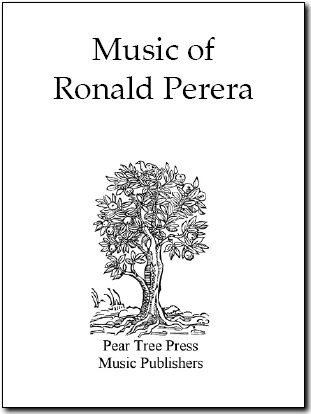

Audio Excerpt:
Nathaniel Watson, baritone; Harvard University Choir; John Ferris, conductor
Narrator, Soprano solo, SATB chorus with Flute (doubling piccolo), 2 oboes (2nd doubling english horn), 2 horns, piano, percussion (one player), 2 cellos, contrabass
Based on The Outermost House by Henry Beston, which recounts the experience of living for a year in a two-room cottage on the beach in Eastham, Cape Cod. With one exception, the odd-number movements are for the narrator, while the even numbers are usually for the chorus with and without the soprano.
Commissioned by the Chatham Chorale, Margaret Bossi, director, in honor of its founder, Marjorie Bennett Morley.
  | The Outermost House: The late Robert Lurtsema narrates these colorful, melodic works. Includes Robert Perera’s The Outermost House performed by Chatham Chorale, Margaret Bossi, conductor, Nancy Armstrong, soprano, Robert J. Lurtsema, narrator and The Canticle of the Sun performed by Chatham Chorale, Margaret Bossi, conductor, Robert J. Lurtsema, narratorand .Available on: Albany Records iTunes |
Movements:
1. East of America
2. My Western Windows
3. A New Sound on the Beach
4. The Sea Has Many Voices
5. Now Come the Sea Fowl
6. Glorious White Birds
7. A Year Indoors
8. That Multiplicity of Insect Tracks
9. The Wreck of the Montclair
10. Night on the Great Beach
11. It Was Still Night
12. My Year Upon the Beach
13. Hold Out Your Hands Over the Earth
| Composed: | 1991 |
| Duration: | 40:00 |
| Publisher: | Pear Tree Press Music Publishing distributed by Subito Music |
| Catalog Number(s): | Vocal Score, Subito 80504202 Conductor’s score and parts available on rental. Hold Out Your Hands Over the Earth available separately: SATB Version, Subito 80504205 SSAA Version, Subito 80504207 TTBB Version Subito 80504208 |
Reviews:
Inspired by the 1927 writing of Henry Beston when he spent a year in virtual solitude at Eastham Beach, “The Outermost House” is a remarkable composition that possesses the musical power to reveal and communicate the many faces of nature when sea, land, sky, wind, and sand collide together in one expansive area. The Saturday night performance was breathtaking, the audience seemingly held spellbound by the unfolding musical drama.
Cape Cod Times 10/16/95
The final piece was “The Outermost House,” for chorus, soprano soloist, narrator and small instrumental ensemble, by Ronald Perera. This lovely work is a setting of the glowing prose of Henry Beston, from his book which recounts the year spent by the author dwelling in a small Cape Cod beach house. The book is a masterpiece of highly evocative nature writing, full of wonderful word pictures and impressions, which Perera beautifully enhanced with his music.
William Warfield, hale and ever-impressive at 81, narrated with dignity and feeling. Alison Chaney’s lovely soprano was a delight. The net effect was that of a masterful tone-painting in praise of one of the world’s very special places.
The Post and Courier, Charleston, South Carolina, 6/3/01
When he is on form, Ronald Perera is among the finest living combiners of words and music alive. The major work here, The Outermost House, is as fine as the best pieces on the CRI disc. Writing on a commission from the Chatham Chorale of Cape Cod, Perera was persuaded to take as his text excerpts from The Outermost House by Henry Beston, which recounts the experience of living for a year in a two-room cottage on the barrier beach in 1925-26. Perera sets his excerptsfor narrator, soprano, chorus, and a small orchestra. With one exception, the odd-number movements are for the narrator (again the very musical Robert J. Lurtsema) while the even numbers are usually for the chorus with and without the soprano (the radiant Nancy Armstrong). As I mentioned in my earlier review, as Perera entered the 90s his idiom was becoming progressively more tonal in orientation. This is also to be found here. The music is simply lovely. Perera’s exquisite ability to set English words is everywhere in evidence as well as his extreme sensitivity to instrumental and vocal color put to service in a text. This is a major addition to the choral repertoire. For choirs able to field the modest additional forces required it should become something of a staple of their repertoire. Albany has put us in their considerable debt by making this marvelous music available to the larger CD-buying public in such a fine performance and recording.
John Story, Fanfare Magazine, May/June 1999 (review of Albany Troy CD 314)
Elegantly crafted, musically appealing, and stirring to the imagination as well as to the heart… Perera has created a musical setting that is more than just worthy of Beston’s masterpiece. It is a work that deserves to be heard often and not just on Cape Cod.
Cape Cod Times 11/18/91
Perera’s music supported graceful vocal writing with warm, embracing sonorities, vibrant rhythms, and (often a distinctive feature of his composition) effectively pictorial use of percussion. The succession of scenes hung together by virtue of returning motives or accompaniment figures which provided clear musical links between sections. The variety in its modes of expression always provided engagement for the ear. Perera had constructed a musical setting perfectly conceived for the diaristic nature of his chosen text, reflecting a barrage of stimuli being interpreted, ordered, and set forth by a single intellect.
Springfield (MA) Union-News 2/18/92
Although wisps of Samuel Barber, Gian Carlo Menotti, and Vincent Persichetti can be heard, Perera’s compositional style is fluent and singular… The last chorus, “Hold Out Your Hands over the Earth,” is a real tour de force. More tonal than the other movements, its universal theme makes it performable as a fine independent work.
Choral Journal 3/94
Perera’s emphasis on the essential elements of melody and harmony — the stuff of which all truly affecting music is made — provides the ideal chamber for the artistic amplification of Beston’s eloquent reflections on nature, compiled during a year spent alone on a Cape Cod beach. While the music is not based strictly on functional principles (standard chord progressions contained within a given key), it is woven persuasively out of the fabric of traditional triadic harmony and unified through the recurrence of seminal motives and key centers. The product is a persuasive marriage of form and content.
Milwaukee Sentinel 2/28/94
The combination of narrative and musical effects make “The Wreck of the Montclair” portion of “Outermost House” a truly powerful experience. Listeners last weekend actually felt the impact of the huge waves and the terror of their fury through Mr. Lurtsema’s dramatic reading of the events that took place in 1927 on a lone stretch of Atlantic beach. We were transported back in time to watch helplessly as the tragedy unfolded. We felt the terror of the sailors caught in an inescapable death trap as the ship was pounded to pieces in the tumultuous surf.
“The Outermost House” remains as a sort of lone witness to both the power and inscrutability of nature. After the tempest, Mr. Perera brought us back to the gentle ebb and flow of life at the beach, and the chorale gave a sublime rendering of the final “Hold Out Your Hands.” We were left with a wonderful sense of acceptance and peace.
The Cape Codder 10/17/95
SATB, SSAA, or TTBB and Piano
The final movement of The Outermost House.
   | The Outermost House: The late Robert Lurtsema narrates these colorful, melodic works. Includes Robert Perera’s The Outermost House performed by Chatham Chorale, Margaret Bossi, conductor, Nancy Armstrong, soprano, Robert J. Lurtsema, narrator and The Canticle of the Sun performed by Chatham Chorale, Margaret Bossi, conductor, Robert J. Lurtsema, narratorand .Available on: Albany Records iTunes |
| Composed: | 1991 |
| Duration: | 4:00 |
| Publisher: | Pear Tree Press Music Publishers distributed by Subito Music Corp. |
| Catalog Number(s): | SATB Version, Subito 80504205 SSAA Version, Subito 80504207 TTBB Version Subito 80504208 |
SATB and Brass quintet, timpani and organ
Composed for the 100th anniversary of St. John’s Church, Northampton, MA.
| Composed: | 1992 |
| Based on: | Psalm 126 |
| Duration: | 4:00 |
| Publisher: | E. C. Schirmer Music Company |
| Catalog Number(s): | 5187 |
Reviews:
This sophisticated setting will require solid brass players. Their music is well crafted and included for optional use by the organ in the absence of brass. The choir parts are challenging, but have been structured so that exposed lines occur in two unison parts, making them easier. Excellent music for advanced choirs. Brass parts are available separately from the publisher.
The Diapason, November 1998
SSA and Piano
The text for this piece is drawn from 19th-century etiquette books. Commissioned by the Smith College Glee Club, Lucinda Thayer, director.
Movements:
1. If You Intend to Sing
2. Few Ladies Adopt the Violin
3. A Fondness for Music
| Composed: | 1993 |
| Duration: | 9:00 |
| Publisher: | Pear Tree Press Music Publishers distributed by Subito Music |
| Catalog Number(s): | PTM 421 |
Speaker and SATB chorus with Flute (doubling alto flute), clarinet in Bb (doubling clarinet in A, bass clarinet, alto sax), violin, viola, cello, bass, piano, percussion
A cantata based on archives of interviews with immigrants who passed through Ellis Island in the early years of the 20th century. Commissioned by the New Amsterdam Singers.
  | Island of Hope: A collection of new American choral music. Includes Ronald Perera’s The Golden Door performed by the New Amsterdam Singers, Clara Longstreth, conductor. On Albany Records, Troy545.Available on: Albany Records iTunes |
Movements:
1. What is your number?
2. America, I wish I was going
3. The fastest and securist transportation
4. Steerage
5. The Lady with her hand up
6. Island of hope; island of tears
7. Names
| Composed: | 1998 |
| Duration: | 23:00 |
| Publisher: | Pear Tree Press Music Publishers distributed by Subito Music |
| Catalog Number(s): | Piano/Vocal Score, PMT 431 Study Score, PMT 431A Performance materials available on rental only |
Reviews:
Island of Hope, the New Amsterdam Singers’ second compact disc recording, offers an eclectic array of contemporary choral music by American composers…. This recording highlights two works with chamber orchestra commissioned by the ensemble. The first of these, set in seven movements by Ronald Perera, is titled The Golden Door. The texts, though diverse in origin, focus on many perspectives regarding immigration. In the opening movement, an incessant agitation of sixteenth notes is used to symbolize the growing frustration of one poor immigrant as the long list of questions posed by the immigration officers takes its toll. In the final movement, a spoken roll call of the names and occupations of recent immigrants is interspersed with the singing of words from the famous Emma Lazarus poem, The New Colossus, found on a plaque at the base of the Statue of Liberty. The work, as a whole, humanizes for the listener many experiences of the people who have come to this country seeking a greater quality of life since the late eighteenth century. It is inspiring and powerful, and admirably performed.
Choral Journal (ACDA), Scott R. Buchanan
The Golden Door . . . is the inspiration for the disc’s title. It is the only substantial work (about 25 minutes) I’ve heard that seeks to evoke the varied experience of immigration to America. Ronald Perera (b. 1941) — whose rewarding music I have reviewed in concert — is a skilled and imaginative musical documenter of aspects of the American experience. He cobbled his own text together from first-hand accounts of immigrants, name-lists, and other “officialese” from Ellis Island archives. It is by turns dramatic, poignant, whimsical, and horrifying — like the section dealing with ship passage in “steerage.” But the piece is finally celebratory and exultant, leaving the listener newly sensitive to — and proud of — our multicultural origins. A small instrumental ensemble offers imaginative support.
Lindsay Koob, American Record Guide
Ronald Perera’s seven-movement work, “The Golden Door,” is based on oral histories of immigrants who entered the United States through Ellis Island… Mr. Perera’s work, for choir and a small ensemble of strings, winds, piano and percussion, is an invitingly consonant and occasionally dramatic overview of the varied paths that the immigrants of several nationalities took to Ellis Island, and those immigrants’ first moments here. One movement, essentially advertising copy for a German cruise ship, had a lilting, salon quality; it was offset by a starker, more lushly harmonized description of the sounds, smells and general discomfort of traveling in steerage.
New York Times 6/14/99
Sunday afternoon’s “American Voices” program by the Chatham Chorale Chamber Singers was just such a powerfully evocative program. Therex was probably not a dry eye in the house as, at the close of a seven-part cantata vividly depicting the arrival of immigrants at Ellis Island, the names and professions of their immigrant ancestors were read aloud by individual chorale members over a soft instrumental underscoring. Premiered in Manhattan just last year by the New Amsterdam Singers, “The Golden Door” was written by Yarmouthport summer resident Ronald Perera, whose “The Outermost House” (based on Henry Beston’s book about Cape Cod) was commissioned and presented by the Chatham Chorale in 1991…no matter if one felt Finch’s pleasing, alternatively thoughtful and playful settings, could have used some of the incisive dramatic touches Perera so skillfully weaves into his musical tapestries, or that “The Golden Door” perhaps needed a few more reflective (shall I say “lyrical” or “memorable”?) passages to balance its teeming, headlong forward momentum. It is enough if the concerted result stirs our imaginations and feelings, leaving us at once excited and teary-eyed, with plenty of food for after-thought.
Cape Cod Times 5/23/2000
SA, SA, SATB (three choir version); SATB; SSAA with Six trumpets, two trombones (three choir version) or keyboard only (SATB and SSAA versions)
Commissioned by Five Colleges, Inc. for the 2000 Five College Choral Festival. It is available in several versions, including for three choirs (SA, SA, and SATB) and brass ensemble, for SSAA chorus and keyboard, and for SATB chorus and keyboard. The text is from The Song of Solomon.
Movements:
1. Behold, thou art fair
2. Rise up, my love
3. Set me as a seal
| Composed: | 1999 |
| Duration: | 5:00 |
| Publisher: | Pear Tree Press Music Publishers distributed by Subito Music |
| Catalog Number(s): | Three Choirs (SA, SA, SATB) Version Choral Score, PMT 441 Brass Ensemble Parts, PMT 441A SATB Chorus and Keyboard Version, PMT 442 SSAA Chorus and Keyboard Version, PMT 443 |
Audio Excerpt:
Combined Choirs of the Five Colleges (Smith, Amherst, Mt. Holyoke, Hampshire, University of Massachusetts Amherst) and brass ensemble conducted by Jonathan Hirsh
Piccolo (doubling flute), 2 flutes, 2 oboes, English horn, 2 clarinets, bass clarinet, 2 bassoons, contrabassoon, 4 horns, 3 trumpets, 3 trombones, tuba, percussion (three players), celesta, harp, accordion, strings
Chanteys, a celebration of ships and the sea, was inspired by the 1976 gathering of tall windships from around the world in honor of the U.S. bicentennial. Supported by a grant from the NEA.
The piece consists of two movements. The first is a fantasy on the beautiful capstan chantey Lowlands, while the second introduces four short-drag chanteys, develops them independently, and then combines them in a quodlibet finale.
| Composed: | 1976, revised 1979 |
| Duration: | 12:00 |
| Publisher: | E. C. Schirmer Music Company |
| Catalog Number(s): | Study Score, 0278 Full score and parts available for rental. |
Reviews:
The final program of the ASUC (American Society of University Composers) conference presented the LSU (Louisiana State University) Symphony Orchestra in a program as varied stylistically as any we could have heard that weekend…. The most convincing works of the concert, however, were a taut, angular oboe concerto by Ursula Mamlock and a remarkably eclectic, coloristic study by Ronald Perera called Chanteys — integrating folk melody, minimalist repetition, many unsettling dramatic thrusts, and a sure hand for orchestration (including, appropriately, an accordion) into a satisfying whole.
Musical America 7/83
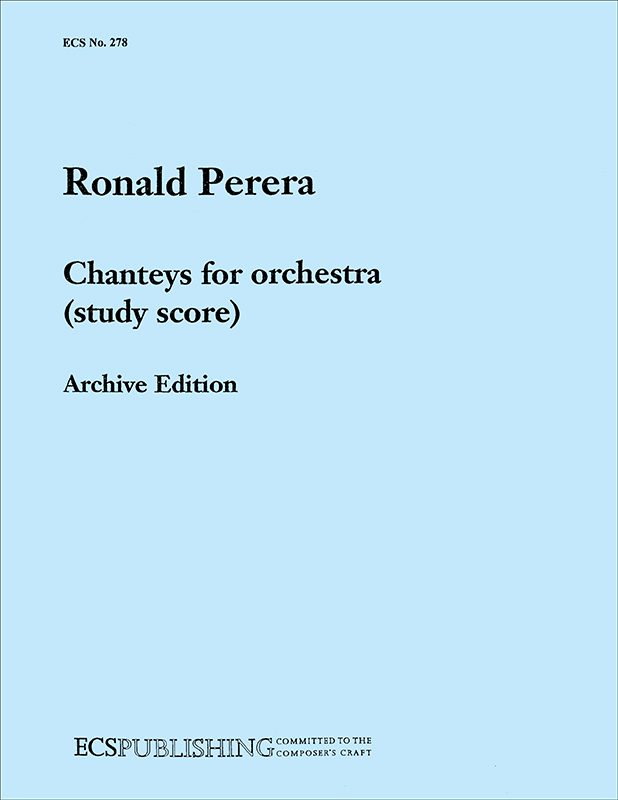

Score Sample:
Audio Excerpt:
Louisiana State University Orchestra, James Yestadt, conductor
Solo brass quintet, 2 flutes (2nd doubling piccolo), oboe, 2 clarinets (2nd doubling bass clarinet), bassoon, horn, trumpet, bass trombone, percussion (2 players), piano
Commissioned for ALEA III and the Empire Brass Quintet, Chamber Concerto does not follow the traditional three-movement Baroque concerto form, but is instead a set of six variations. It pays homage to the Baroque and Classical styles in its concern for symmetry, traditional chord structures, felt meters, uncluttered textures, and solo instrumental writing that demands virtuosity without recourse to the non-traditional playing techniques and special effects prevalent in much contemporary music.
| Composed: | 1983 |
| Duration: | 20:00 |
| Publisher: | E. C. Schirmer Music Company |
| Catalog Number(s): | Study Score, 4096 Full score and parts available for rental. |
Reviews:
Perera’s “Chamber Concerto” received its premiere Wednesday night. At 21 minutes it was by far the longest work on the program. It is actually a set of seven variations in which a brass quintet (The Empire) coexists, contentedly and otherwise, with an orchestra of woodwinds and percussion. Perera has an acute ear for sonority. There was a gripping opening dialogue between on and off-stage trumpets, vivid use of various mutes, some stirring bell sounds (Boris Godunov came to mind), wildly swirling wind writing, and floor-shaking bass. Despite a lack of subtlety (at least in this performance), and emphasis on sound per se, Perera’s instantly accessible music compels attention through its sheer visceral impact.
Boston Globe 3/21/84


Score Sample:
Audio Excerpt:
Empire Brass Quintet and ALEA III, Theodore Antoniou, conductor
From Variation 5:
2 flutes (2nd doubling piccolo), 2 oboes, 2 clarinets (2nd doubling bass clarinet), 2 bassoons, 2 horns, 2 trumpets, 2 trombones, tuba, timpani, 2 percussion, harp, piano, solo flute, strings
The music that begins and ends Music for Flute and Orchestra is marked “very rhythmic; dancing” in the score, and it presents a shifting array of sharply etched melodic motives in rapidly changing meter. That edgy, jazzy music encloses a central core of calmer music, roughly twice as slow (or half as fast), which enlarges upon the same melodic ideas. This work was written for flutist William Wittig.
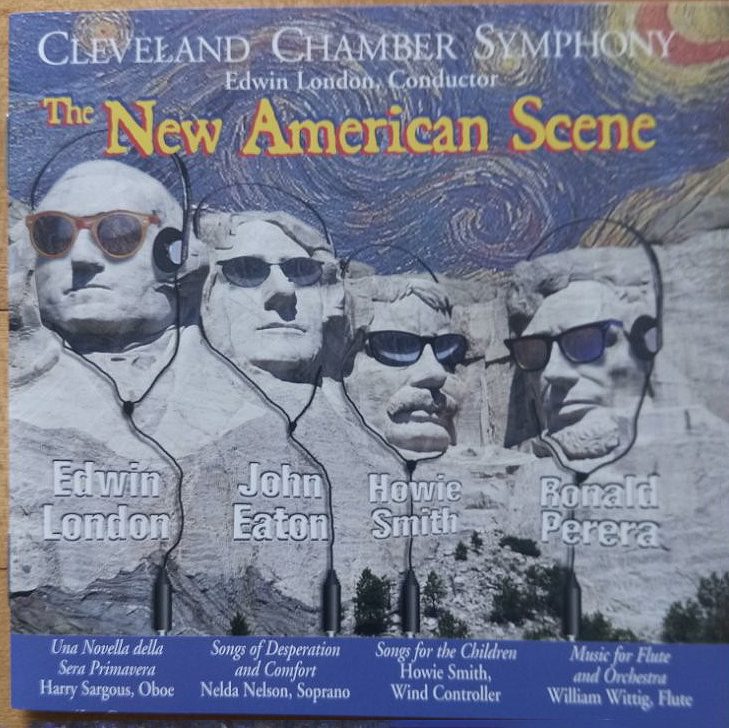

The New American Scene: Including Ronald Perera’s Music for Flute and Orchestra, performed by the Cleveland Chamber Symphony, William Wittig, flute, Edwin London, conductor. On Albany Records, Troy298. Available on:
Albany Records
iTunes
| Composed: | 1990 |
| Duration: | 10:00 |
| Publisher: | Pear Tree Music Publishers distributed By Subito Music |
Reviews:
A single movement sandwiching some delicate, contemplative “night music” between sections driven by rambunctious, angular motivic hijinks, Perera’s colorfully scored, tightly conceived work gave the orchestra an opportunity to enjoy greater extremes of expression than Mozart would allow. It also called into play a modestly sized but deftly employed percussion section, punctuating the musical conversation between flute and orchestra with a tam-tam stroke here, the pearly note of a crotale there, and carefully placed cymbal crashes of varying intensity. Smith and the SSO gave the Perera an enthusiastic, incisive reading. Its calculatedly capricious meter changes seemed well assimilated by conductor and orchestra, and the whole flowed with admirable organic smoothness.
Springfield (MA) Union-News 2/8/99
Perera treats the flute as a seductive and temperamental protagonist, sending the soloist on fanciful flights and tuneful adventures that complement the sometimes grand rhetoric of the orchestra.
The Cleveland Plain Dealer 4/16/97
Audio Excerpt:
William Wittig, flute, Cleveland Chamber Symphony, Edwin London, conductor
2 flutes (2nd doubling piccolo), 2 oboes, 2 clarinets (2nd doubling soprano saxophone), alto saxophone, tenor saxophone, 2 bassoons, 2 horns, 2 trumpets, 2 trombones, tuba, timpani, percussion (one player), optional banjo, piano, strings, tape playback system (cassette)
The Saints is based on When the Saints Go Marching In, a Dixieland classic that tradition holds was played at funerals in New Orleans around 1900 — slowly on the way to the cemetery and quickly coming back.
Each of the three pieces in The Saints is designed to explore and illustrate a musical idea. The opening piece, Choirs, shows off the musical families of the orchestra. The second, Joyful Noise, presents many extended instrumental sounds and special effects. The third, Marching In evokes the slow march to the cemetery and the jazzed-up procession home.
This work was commissioned by the 92nd Street Y in New York City for its Sidney A. Wolff School Music Series.
Movements:
- Choirs
- Joyful Noise
- Marching In
| Composed: | 1990 |
| Duration: | 10:00 |
| Publisher: | Pear Tree Press Music Publishers distributed by Subito Music Corp. |
Reviews:
A concise deconstruction of “When the Saints Go Marching In” spanning a pocket concerto for orchestra, electronics-enhanced compositional play, and some respectable symphonic second-lining (including a proficiently primed audience sing-along), “The Saints,” in design and performance, illustrated the evening’s other virtues: invention, craft, judicious renewal of commonplaces. As travel so often does, Perera’s New Orleans jaunt crystallized the virtues of home.
Boston Globe, April 1, 2017
Score Sample:
Audio Excerpt:
Performed by The Boston Modern Orchestra Project. Conducted by Gil Rose, Artistic Director.
1. Choirs
2. Joyful Noise
3. Marching In
Mezzo-soprano with Piano or with Chamber Orchestra [Harp, piano (doubling celesta), percussion (one player), and strings]
Five songs on poems of Emily Dickinson. The original version (1972) was composed for medium voice and piano (E. C. Schirmer Music Company #0161). The Chamber Orchestra arrangement was commissioned by the Cleveland Chamber Symphony.
Poems included:
- New Feet Within My Garden Go
- South Winds Jostle Them
- I Know a Place
- To Make a Prairie
- The One That Could Repeat the Summer Day.
  | American Music for Flute, Voice, and Strings: A collection of American music by various composers. Includes Ronald Perera’s Five Summer Songs performed by soprano Carole Wilson. On Albany Records, Troy519.Available on: Albany Records iTunes |
| Composed: | 1972/1993 |
| Duration: | 12:00 |
| Publisher: | E. C. Schirmer Music Company |
| Catalog Number(s): | Medium Voice, Piano Version, 0161 Mezzo-Soprano and Chamber Orchestra Version, 4096 Orchestra score and parts on rental. |
Reviews:
Rec. lyric medium voice (b-f#2); 12:00; titles are: New Feet Within My Garden Go; South Winds Jostle Them; I Know a Place; To Make a Prairie; The One That Could Repeat the Summer Day; best kept as a set; excellent variety of mood and color; atonal, but with a strong feeling of tonality throughout; gentle dissonances; not difficult for the voice, but the colorful piano writing is intricate and requires dexterity; elegant, lyrical, compelling songs.
A Singer’s Guide to the American Art Song 1870-1980by Victoria Etnier Villamil (The Scarecrow Press, Inc., Metuchen, NJ & London, 1993)
Perera’s thoroughly pleasing and admirably written set of songs would grace any singer’s repertory. The unadorned style and clarity of the musical language make the set an attractive proposition for a beginner to the field. The “Five Summer Songs” could be put with other Emily Dickinson settings. They would not seem out of place in a traditional recital program because of their unpretentious and direct appeal. The set would form a good foil for late Romantic lieder with more exotic textures.
New Vocal Repertory by Jane Manning (Taplinger, 1987)
With detailed instructions for both the singer and accompanist these songs are wonderful for an accomplished, artistic, sensitive singer.
NATS Bulletin 5/78


Score Samples:
Audio Excerpt:
5. “The One that Could Repeat the Summer Day,” Carole Wilson, soprano, Budapest Camerata, Adrian Sunshine, conductor

